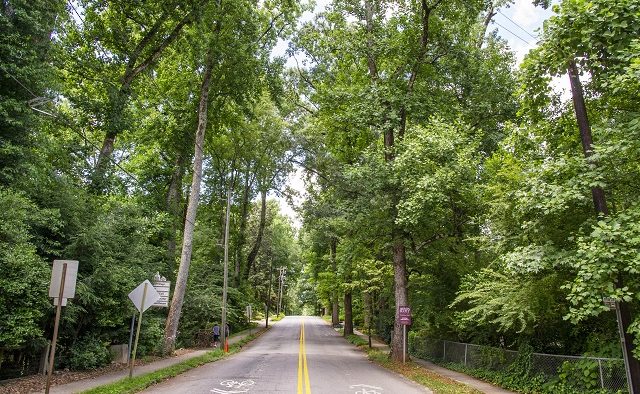Concerns about tree canopy loss arise while amending Decatur’s tree ordinance
 Trees along S. McDonough Street. Photo by Dean Hesse.
Trees along S. McDonough Street. Photo by Dean Hesse.
Editor’s note: This story originally appeared in our e-edition, an exclusive product for our paying supporters. To become a paying supporter of Decaturish, visit supportmylocalnews.com
Decatur, GA — The city of Decatur is in the process of amending its tree ordinance and concerns about tree canopy loss have been brought up throughout those conversations.
Records provided by the city show an increase in the number of trees being removed each year.
Decatur resident Ash Miller created a graph based on a public records request that shows the number of trees removed and tree canopy lost in the city has accelerated over the past five years. Miller also serves on the natural systems committee of the Decatur Environmental Sustainability Board. Miller has helped the board make recommendations on the tree ordinance.
In his analysis, Miller found that tree loss nearly doubled in 2020 as compared to 2015, he said.
The city of Decatur has maintained its canopy since 2009, remaining at about 57% canopy coverage, City Arborist Kay Evanovich said.
“It looks like a lot of canopy square footage was removed. You could argue that but when you look at the whole picture, again, how much was preserved, how much was planted back, when you look at the actual numbers we still have 57% canopy,” Evanovich said.
The number of trees that have been removed year to year has increased overall since 2017. Two hundred and twelve trees were removed in 2017; 206 trees in 2018; 309 trees were removed in 2019 and 383 trees were removed in 2020, according to a report from Evanovich.
The most recent tree canopy study was presented to the Decatur City Commission during a work session on March 1. The presentation states that the total canopy area remains at about 57% and that areas of gain have been found with new plantings and street trees, as well as continued growth of established trees.
The city has seen some tree loss due to single-family redevelopment, new townhomes and commercial developments, the expansion of existing institutional developments and discretionary tree removal or loss due to storms, according to the presentation.
Evanovich told Decaturish that she has received many requests for additions to homes during the COVID-19 pandemic and add that the city is carefully watching how much root zone is affected by projects.
Miller said that the trend from his analysis of accelerated tree loss in the city highlights the need to improve the city’s tree ordinance.
“It shows how weak the current ordinance is and how much we need a stronger tree ordinance and the reason that’s important is the city has a goal of increasing tree canopy by 10% over the existing canopy,” Miller said. “The canopy study found no gain of trees in 10 years, 2009 to 2019. This shows that we’ve probably lost trees overall, lost canopy.”
Under the current ordinance, the tree canopy coverage goal is set at 50% and the Environmental Sustainability Board has advocated for that percentage to increase to 63%.
“[The city] changed their method of measuring canopy so to maintain our current goal we need to set the new goal at 63%, but they don’t seem willing to go above 60% right now,” Miller said. “That’s a loss of 85 acres of trees. I think this is really significant.”
Evanovich explained that the 50% goal was established in the ordinance in 2009 and 2014 because the city didn’t think they had 50% canopy coverage.
At the April 30 Environmental Sustainability Board meeting, Evanovich explained the original reason for increasing to 50% around 2013. Arborists and others working on climate change at the time agreed that if cities could get up to 50% then that would be enough canopy coverage to address climate change issues.
Evanovich said at the meeting that 63% may not be achievable and maintainable. She added that 50% is maintainable and 60% may be also.
“I think really 60% is really pushing it at the max for canopy cover for a city like ours,” Evanovich said at the meeting. “So, I’m just saying going forward I think if we set it at 60% then we are growing canopy. We are trying to achieve that 60% through more preservation and more planting and continued growth on the ones we’ve already planted. I think that’s a good direction for any city to go in.”
She told Decaturish that 60% is a good number for an urban forest that wasn’t planned for trees. She thinks that going higher than 60% could cause problems with trees not having enough space for roots to grow and be able to support the top of the tree.
The ESB would also like to see clearer legal standards in the ordinance, as well as a tree information online portal.
“We need to protect our most valuable trees, they’re called priority trees in the ESB draft, and we need a tree board and a tree task force to help improve enforcement which will be necessary because there will be more protections,” Miller said. “They just need to be empowered to help take some work off of city staff’s plate, I think. They could have a subcommittee to hear appeals and develop a tree census, a species list, all of this is in the ESB recommendations.”
The city is still in the process of amending the tree ordinance, and Evanovich anticipates that a draft of the ordinance will be made available for public review in the next couple of weeks.
If you appreciate our work, please become a paying supporter. For as little as $3 a month, you can help us keep you in the loop about your community. To become a supporter, click here.
Want Decaturish delivered to your inbox every day? Sign up for our free newsletter by clicking here.
